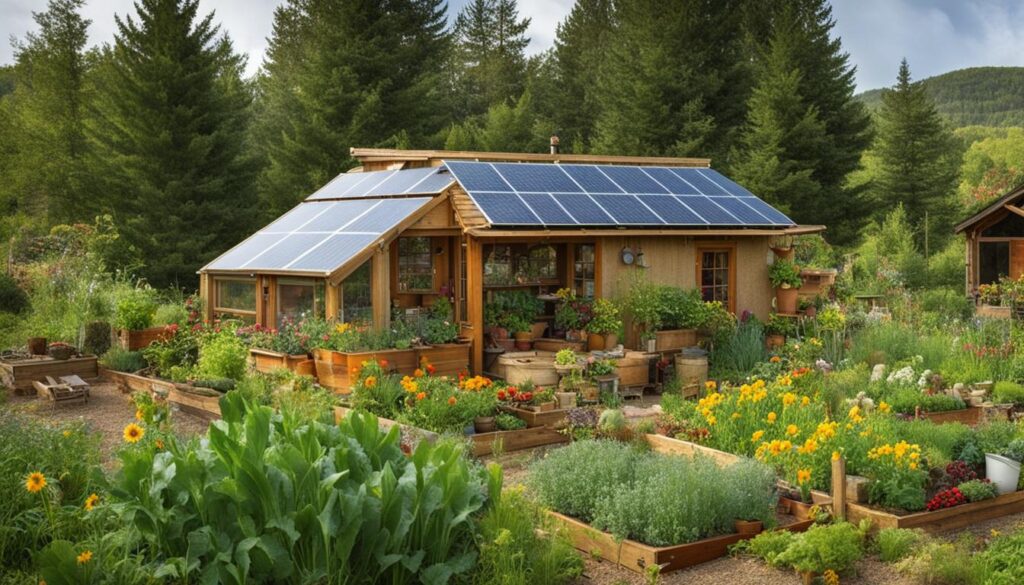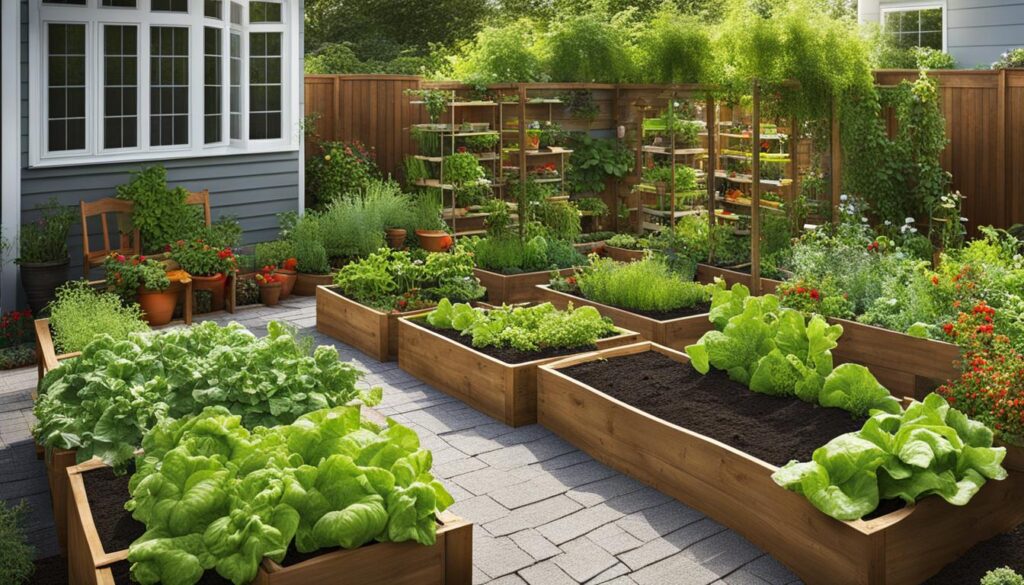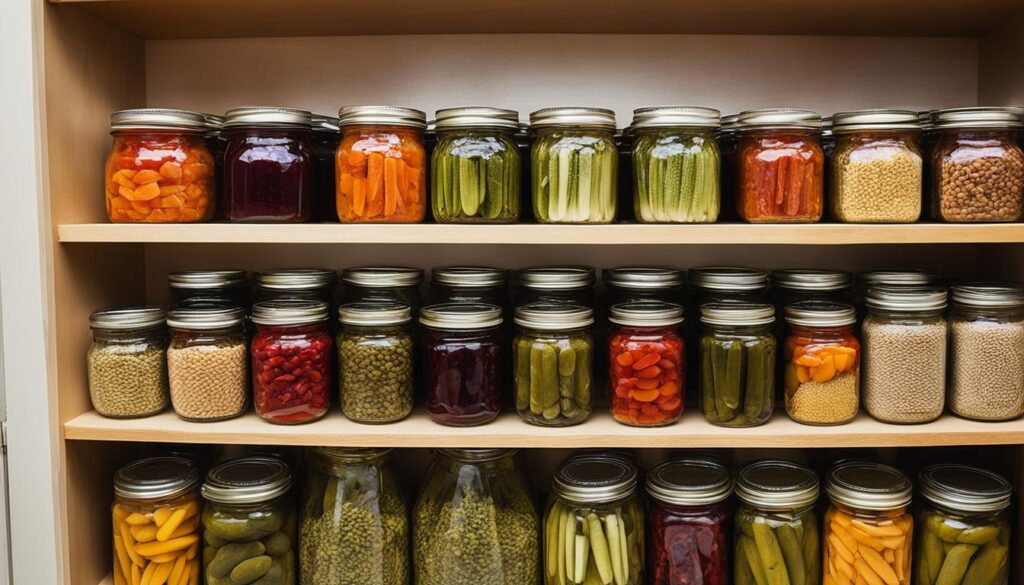
Food preservation techniques have long been utilized to ensure a reliable food supply, especially during times of scarcity. From drying fish to fermenting grapes, our ancestors developed various methods to preserve food for the long term. While modern refrigeration and easy access to fresh produce have reduced the need for long-term food storage, maintaining a well-stocked pantry still holds numerous benefits.
Building a pantry for self-reliance is vital, offering advantages such as emergency preparedness, budget-friendly purchasing, and the ability to plan ahead. By stocking up on essentials and utilizing different food preservation techniques, you can ensure a sustainable and nutritious food supply.
Key Takeaways:
- Long-term food storage methods have been practiced for thousands of years.
- A well-stocked pantry aids in emergency preparedness.
- It allows for budget-friendly bulk purchases.
- Food preservation techniques help in planning for the future.
- By preserving fruits, vegetables, meats, and other items, you can ensure a diverse and sustainable pantry.
Importance of a Pantry for Self-Reliance
Long-term food storage is a critical aspect of self-reliance and emergency preparedness. Having a well-stocked pantry ensures that you are ready for unforeseen events that could disrupt the food supply chain. It also allows you to maintain a family budget by purchasing low-cost foods in bulk and storing them for future use. Additionally, a pantry plays a vital role in planning your homestead projects, such as maintaining a garden and raising livestock. By storing an ample food stockpile, you can ensure that your family has enough sustenance throughout the year.
A well-stocked pantry is essential for self-reliance and emergency preparedness.
Stocking Your Pantry with Fruits and Vegetables
When it comes to building a well-rounded pantry, fruits and vegetables are essential. These nutritious and versatile food items can be preserved in various ways to ensure they remain available for long periods. Let’s explore some popular methods of preserving fruits and vegetables: canning, dehydrating, fermenting, and pickling.
Canning
Canning is a widely used method of preserving fruits and vegetables. It involves sealing fresh produce in airtight containers, such as jars, with the help of heat. Canned fruits and vegetables retain their flavor, texture, and nutritional value, making them a great addition to any meal. Stocking your pantry with canned foods provides you with a convenient and long-lasting supply of fruits and vegetables.
Dehydrating
Dehydrating is another popular method of food preservation. By removing the moisture from fruits and vegetables, dehydrating extends their shelf life while concentrating their flavor. Dehydrated foods are lightweight, compact, and easy to store, making them perfect for camping trips or emergency situations. Including dehydrated fruits and vegetables in your pantry ensures you have a selection of nutrient-rich ingredients ready to use whenever you need them.
Fermenting
Fermentation is an ancient technique that involves the transformation of sugars in fruits and vegetables by bacteria, yeasts, or fungi. This process creates an environment rich in probiotics, enzymes, and beneficial bacteria, enhancing the nutritional value and taste of the preserved foods. Fermented fruits and vegetables, such as sauerkraut or kimchi, not only provide a tangy and flavorful addition to your meals but also improve gut health.
Pickling
Pickling is a method of food preservation that involves immersing fruits and vegetables in a solution of vinegar, salt, and spices. This process not only preserves the produce but also enhances its flavor and adds a satisfying crunch. Stocking your pantry with pickled fruits and vegetables allows you to enjoy their tangy and piquant taste throughout the year.
Proper calculation of the amount of each fruit and vegetable you need based on your family’s consumption is crucial for effective pantry stocking. Consider the shelf life of various preserved foods and plan accordingly. Additionally, planting and growing your own fruits and vegetables can be a rewarding way to ensure a fresh supply for preserving and stocking your pantry with the best-quality produce.
Remember, a well-stocked pantry with a variety of preserved fruits and vegetables is key to long-term self-reliance and a sustainable food supply.
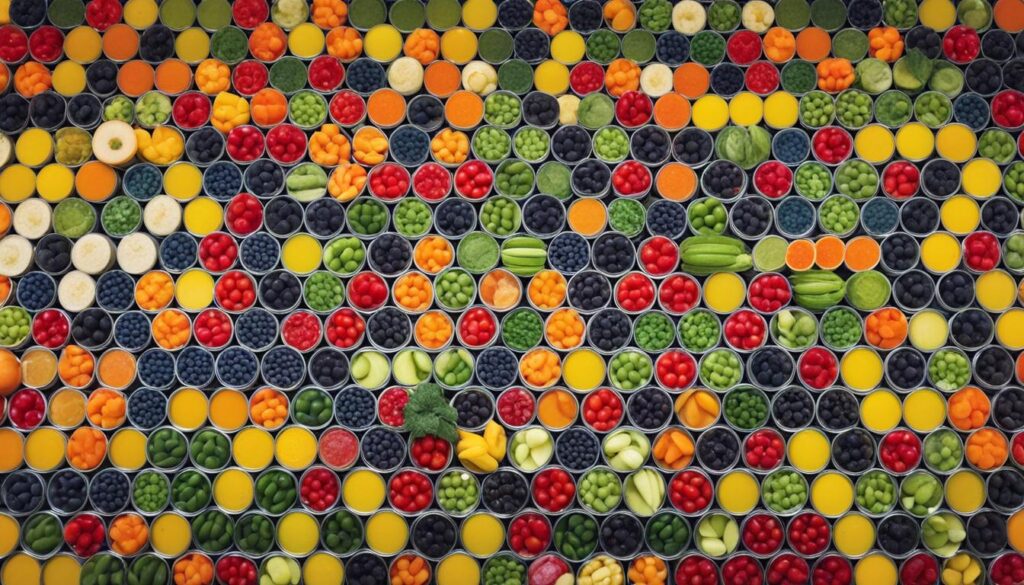
Incorporating Pickles, Jams, and Jellies into Your Pantry
Adding homemade preserves, pickles, jams, and jellies to your pantry can provide a burst of flavor to your meals. These items are not just for immediate consumption but can be preserved for long-term use. Stock your shelves with a variety of flavors that suit your taste preferences. Homemade preserves not only add taste but also enhance the nutritional value of your meals.
The Benefits of Homemade Preserves, Pickles, Jams, and Jellies
When it comes to incorporating homemade preserves into your pantry, the possibilities are endless. Whether you enjoy the tangy crunch of pickled vegetables or the sweet spread of homemade jams and jellies, these preserved treats can elevate your meals and provide a touch of homemade goodness.
One of the main benefits of homemade preserves is the control you have over the ingredients. You can choose the freshest fruits and vegetables, ensuring that your preserves are made with quality produce. Additionally, homemade preserves often contain fewer additives and preservatives compared to store-bought versions, making them a healthier choice for you and your family.
Incorporating homemade pickles, jams, and jellies into your pantry also allows you to customize flavors according to your preferences. You can experiment with different combinations of fruits, vegetables, and spices to create unique and delicious preserves. This gives you the freedom to tailor your pantry to suit your taste buds.
Getting Started with Homemade Preserves
If you’re new to the world of homemade preserves, don’t worry! There are plenty of resources available to help you get started. From canning recipes to step-by-step guides, you’ll find everything you need to embark on your own preserving journey.
Pro tip: Start with small batches to gain confidence and experience in the preserving process. As you become more comfortable, you can increase the quantities and try more adventurous recipes.
A Variety of Homemade Preserves to Fill Your Pantry
When it comes to homemade preserves, the options are limitless. From classic strawberry jam to zesty dill pickles, you can create a diverse range of preserves to suit every taste. Here are some popular options:
- Strawberry Jam
- Raspberry Jelly
- Peach Chutney
- Dill Pickles
- Spicy Pepper Jelly
- Blueberry Compote
By stocking your pantry with a variety of homemade preserves, you’ll always have delicious options at your fingertips. Whether you’re enjoying a slice of toast in the morning or adding a kick to your cheese platter, homemade preserves can elevate any meal or snack.
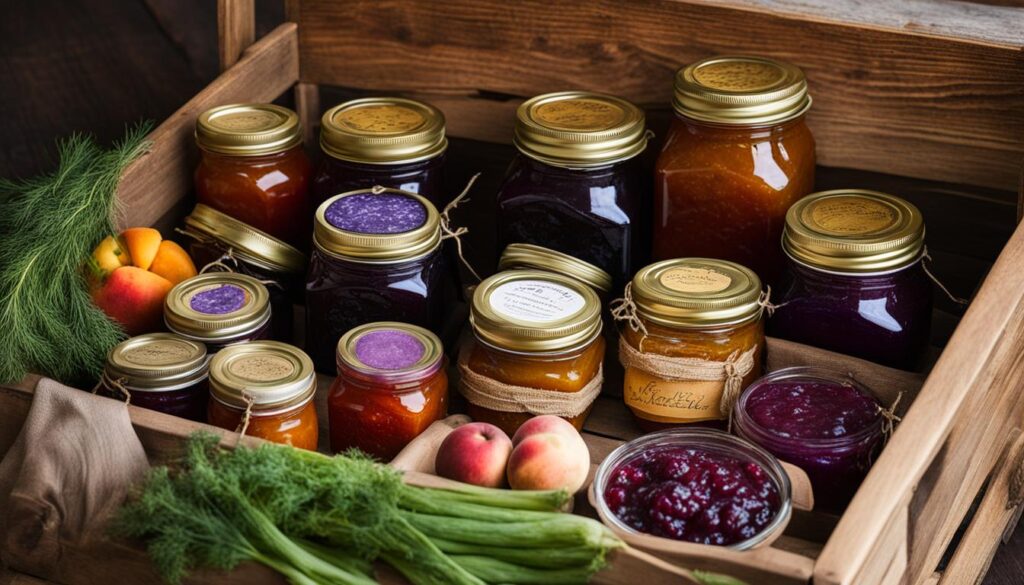
| Preserve Type | Flavor | Best Pairings |
|---|---|---|
| Strawberry Jam | Sweet and tangy | Toast, scones, yogurt |
| Raspberry Jelly | Bright and fruity | Peanut butter sandwiches, pancakes |
| Peach Chutney | Sweet and spicy | Cheese platters, grilled chicken |
| Dill Pickles | Tangy and crunchy | Burgers, sandwiches, salads |
| Spicy Pepper Jelly | Sweet and fiery | Cheese and crackers, glazes for meat |
| Blueberry Compote | Sweet and juicy | Pancakes, waffles, ice cream |
Canning Meats for Long-Term Storage
When it comes to preserving meats for long-term storage, canning is a convenient and reliable method. While freezing is a common approach, canning offers several advantages, making it a popular choice for those looking to stock their pantries with home-canned meat.
One of the key benefits of canning meats is the versatility it offers in meal preparation. Canned meats can be easily incorporated into a variety of dishes, such as hearty soups, savory stews, and flavorful casseroles. You can enjoy the convenience of ready-to-use meat without the need for defrosting, saving you time and effort in the kitchen.
Another advantage of home-canned meat is its long shelf life. Properly sealed and stored, canned meats can last for several years, providing a valuable source of protein during emergencies or times when fresh meat is not readily available. Having a stock of home-canned meat ensures that you always have a reliable food source on hand, giving you peace of mind and the ability to sustain your family’s nutritional needs.
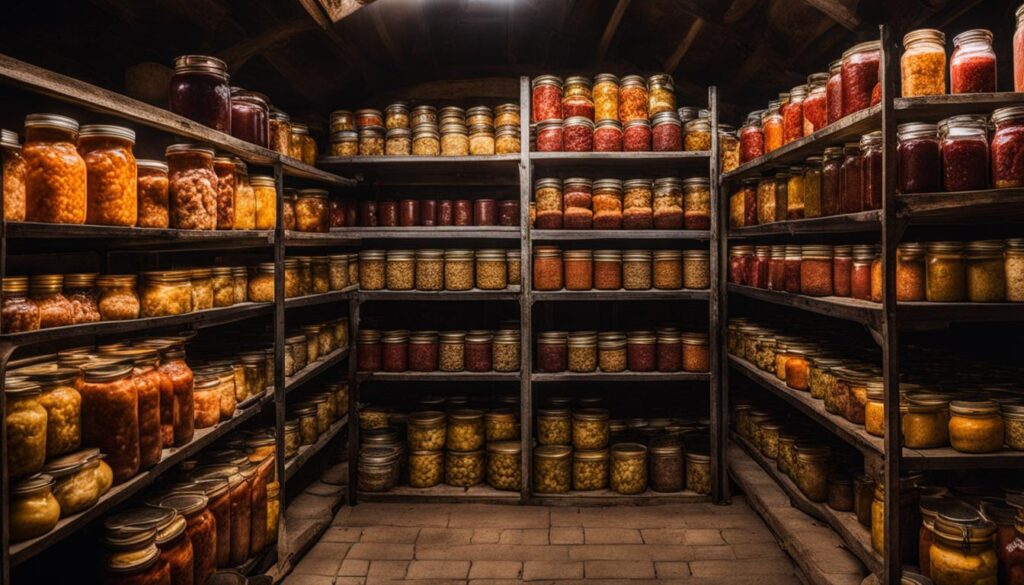
Furthermore, canning your own meat is a cost-effective form of food preservation. Compared to buying commercially canned meat, canning your own meat allows you to control the quality, portion sizes, and flavor profiles. By purchasing meat in bulk and canning it yourself, you can save money and customize your pantry items according to your preferences.
In summary, canning meats for long-term storage is a practical and cost-effective food preservation method. With its versatility, extended shelf life, and economic benefits, home-canned meat should be a staple in your pantry for both everyday meals and emergency situations.
Conclusion
As we wrap up our discussion on long-term self-reliance and sustainable food preservation, it is clear that building a well-stocked pantry is a vital step to ensure food security. By incorporating various food preservation methods into our routines, such as canning, dehydrating, and pickling, we can create a diverse supply of nutritious and cost-effective options.
One of the key food storage tips for long-term self-reliance is to regularly assess the contents of our pantry. By rotating items and planning our food preservation efforts based on the needs and preferences of our families, we can maintain a sustainable food supply that meets our requirements.
In uncertain times, having a pantry stocked with preserved foods provides peace of mind and ensures we are prepared for any situation that may disrupt the food supply chain. By following these food storage tips and embracing sustainable food preservation practices, we can achieve long-term self-reliance and confidently navigate the challenges that may come our way.
FAQ
Why is long-term food storage important for self-reliance?
Long-term food storage is important for self-reliance because it allows you to be prepared for unexpected events that may disrupt the food supply chain. It also helps you maintain a family budget by purchasing low-cost foods in bulk and storing them for future use.
What are some common food preservation methods for long-term storage?
Some common food preservation methods for long-term storage include canning, freezing, dehydrating, fermenting, and pickling.
How long can canned or dehydrated fruits and vegetables be stored?
Canned or dehydrated fruits and vegetables can be stored for a long time, up to several years, if properly sealed and stored in a cool, dry place.
Can homemade preserves and pickles be stored for the long term?
Yes, homemade preserves and pickles can be stored for the long term. Properly sealed and stored in a cool, dark place, they can last for several years.
What are the advantages of canning meats for long-term storage?
Canning meats provides a convenient option for long-term storage. Canned meats can be used in various dishes without the need for defrosting, making meal preparation easier. Additionally, canning your own meat is cost-effective compared to buying canned meat from stores.

